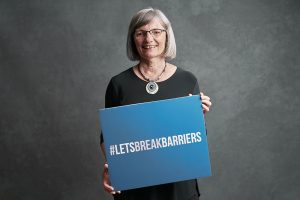Tannen Horber is a recent graduate from Ryerson University’s Master of Professional Communication program. Tannen is passionate about using communication strategies as a vehicle for social change and focused her Major Research Project (similar to a thesis) on the representation of women in the public sphere. Tannen has recently joined the CCRM team as a Communication Coordinator.
My mother’s friend was a biology undergrad at York University in the late eighties. She was passionate, driven and dreamt of one day becoming a biomedical engineer. When I asked her why she had so drastically changed careers paths (knowing that she was now a high school science teacher, an equally important job, yet quite different from the profession she had once envisioned for herself), she answered by painting a bleak picture of women in STEM.
In 2020, Catalyst released a report indicating that the number of women pursuing careers in STEM fields remains staggeringly low when compared to their male counterparts. The report also highlights the latest trends in the representation (correction: underrepresentation) of women in STEM in Canada, Europe, the United States and the Asia Pacific region. On a global scale, men still dominate the STEM workforce with women making up less than 30 per cent of individuals in scientific research and development around the world. In 2017-2018, 38 per cent of women were enrolled in STEM related post-secondary studies in Canada; however, enrolment rates didn’t translate into employment opportunities. In Canada, in 2019, women made up less than one quarter of those employed in natural, applied and associated science positions. And of those women who actually managed to secure a position, the Catalyst report shows they earned $0.76 for every $1.00 earned by a man in the same role.
Is this surprising? Probably not. Nevertheless, as a relatively new member to the world of STEM and health sciences, I took it upon myself to dig deeper into the gender gap to understand how we can better support women in these still male-dominated fields.
Having said that, women are coming up with unique and innovative strategies to stand out in the STEM workforce every day. Here are two stories of brave women who blazed their own trail in these male dominated sectors.
Dr. Valerie Davidson
In a 2018 article for McMaster Universities #BigIdeas stories, Valerie Davidson discussed her career as a student, researcher and academic in engineering. Dr. Davidson began as one of four female students in her first-year engineering program in 1971. After completing an undergraduate degree in Chemical Engineering, Dr. Davidson went on to obtain a Master’s degree and later a PhD in Chemical Engineering.
Fearing the academic world would not enthusiastically welcome a woman, Dr. Davidson worked as an engineering consultant and in manufacturing before finally realizing her innate desire to teach. Between 1988 and 2013 (until Dr. Davidson retired), she dedicated her expertise and time to mentoring and ensuring that young women seized opportunities to join engineering faculties across Canada and spent decades working to encourage women to choose STEM careers.
Most notably, Dr. Davidson founded the Ontario Network on Women in Engineering (ONWiE) – a network of 26 engineering schools across Ontario that are working together to create programs and encourage women to pursue a career in engineering. The organization’s programs boast an average of 2,000 participants per year. Here’s an excerpt from Davidson’s story that I found particularly compelling:
“At that time there were only a few women’s washrooms in the engineering building,” recalls Davidson. “I do remember climbing at least two flights of stairs from our basement study room to reach a women’s washroom, and I often thought of using a can of black spray paint to mark “wo” on a few of the men’s facilities.”
Melinda Gorgenyi
While reviewing the Catalyst report, I came across Melinda’s story. When Melinda Gorgenyi began her career as a young female civil engineer, the expectation was that she would work overtime and be available around the clock to run back to the construction job site. Usually, Melinda would be the only female on the team and since she often worked in remote environments, she took up kickboxing as a confidence booster as well as to defend herself on the job should the need ever arise.
Thankfully, Melinda found success and rose through the engineering ranks with support from her male colleagues. Melinda realized the necessity and value of having open conversations about gender parity and diversity in the workplace and joined Sodexo’s (her current employer) SoTogether female resource group. Female employee resource groups (ERGs) can be powerful tools which help women help each other to understand their contextualized challenges in the field.
Melinda’s message to the facilities management industry? Incentivization – promote different career paths available for women who are equally entitled to a fair work-life balance and level the leadership ascension pathway so women can have mentors at the top who understand their unique positions in the industry.
Ironically, what this all means is that women are expected to go overboard just to receive the same treatment as a man and special programs are still required to level the playing field. Sigh…
Thus, I have begun to think of women in STEM as stem cells – constantly having to “renew” or reinvent themselves to find success in an inequitable workplace.
After following up with my mother’s friend, she reflected on her past and “what could have been”. Although she does not regret her decision to leave industry, she has made it a small goal of her own to encourage the young women in her classes to continue with their studies in the sciences. Her mission is to empower and educate the next generation of young women to pursue a career in STEM.
If you have your own story to share about women in STEM, please post it in the Comments section.
Guest
Latest posts by Guest (see all)
- Regenerative immunotherapy: Hope for chronic autoimmune diseases - September 16, 2025
- Canada’s regenerative revolution: Why AI is the catalyst - September 4, 2025
- Summer by Design: A launchpad for future entrepreneurs and industry scientists - August 14, 2025








Comments